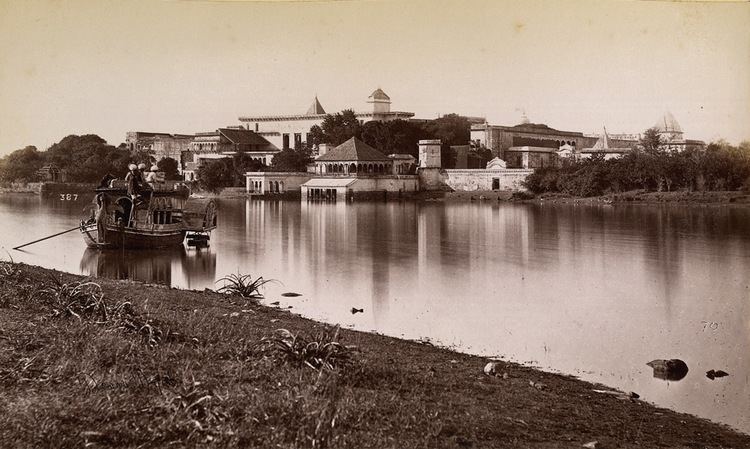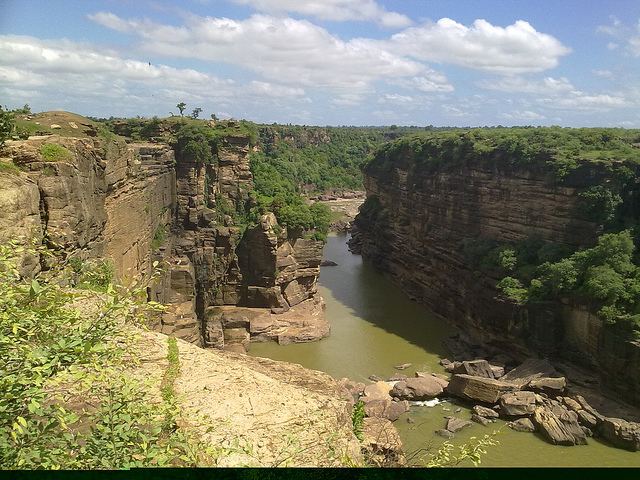Population 183,274 (2001) Languages spoken Hindi, Bagheli District | ||
 | ||
University Awadhesh Pratap Singh University | ||
Map of Rewa, Madhya Pradesh
Rewa pronunciation is a city in the north-eastern part of Madhya Pradesh state in India. It is the administrative centre of Rewa District and Rewa Division. The city lies about 420 kilometres (261 mi) northeast of the state capital Bhopal and 130 kilometres (81 mi) south of the city of Allahabad. Rewa derives its name from another name for the Narmada River. Rewa is connected to Allahabad via NH 27 and Sidhi, Satna, Maihar and Varansi via NH-7. In nearby Sidhi district, a part of the erstwhile princely state of Rewa, and now a part of Rewa division, the world's first white tiger, a mutant variant of the Bengal tiger, was caught. Worlds first white tiger safari is located in Satna district of Rewa division.
Contents
- Map of Rewa Madhya Pradesh
- Keoti falls near rewa in mp india
- Climate
- Demographics
- History
- Economy
- Handicrafts
- Tourism
- Metals and Minerals industries
- Agriculture
- Retail
- Vindhya Mahotsav
- Education
- Government universities
- Engineering colleges
- Medical colleges and Hospitals
- Polytechnic colleges
- Other colleges
- Rail
- Road Air
- Notable people
- Places to visit
- Industries
- References

Keoti falls near rewa in mp india
Climate
Rewa has a humid subtropical climate, with cold, misty winters, a hot summer and a humid monsoon season. Summers start in late March and go on till mid-June, the average temperature being around 30 °C (86 °F), with the peak of summer in May, when the highs regularly exceed 45 °C (104 °F). The monsoon starts in late June and ends in late September. These months see about 40 inches (1025 mm) of precipitation. The average temperature is around 25 °C (77 °F) and the humidity is quite high. Temperatures rise again up to late October when winter starts, which lasts up to early March. Winters in Rewa are cold and misty with average temperatures around 15 °C (58 °F) and little rain. The winter peaks in January when temperatures may drop close to freezing on some nights. The total annual rainfall is about 1128 mm (44 inches).
Demographics
As of 2011, Rewa had a population of about 2,354,220. out of which 1,219,980 are males and 1,134,240 are females. Rewa has an average literacy rate of 53.42%, male literacy is 63.67%, and female literacy is 42.49%. In Rewa, 14.41% of the population is under 6 years old.
History
The district derives its name from the town of Rewa, the district headquarters, which is another name for the Narmada River. The territories now included in the district were held by the imperial Maurya dynasty, which ruled in the 3rd century BC. The area came under the Kalachuris from the 9th to the end of 12th century. In the 13th century, Ulugh Khan, brother of Sultan Alauddin, drove the Baghela king east into the area, where he founded the Princely State of Rewa. This dynasty continued until the last successor, Martand Singh, abdicated and acceded rule to the Dominion of India in 1947. The present Rewa district came into existence in 1950 when the Provinces and States Order (transfer of enclaves) was put into effect. Prior to August 1947, the district, along with the Raghurajnagar tehsil of the former Rewa state, corresponded to that state's north Rewa district.
Before independence, hunting tiger was considered honourable in India. Once the Rewa King went for hunting, and he found an odd white-coloured tiger, called Mohan. Mohan was sent to others to continue his breed; all of today's white tigers are thought to be Mohan's progeny. A famous Rewa leader, Shri Nivaas Tiwari, was called "White Tiger of Rewa". Authorities planned to make a zoo in Rewa, named for the White Tiger which has been under dispute. This first white tiger safari or zoo was established by the Central Zoo Authority of India in Mukundpur.
The central committee on pre-independence files recently released files giving insight on the Indian independence movement in Rewa. These include case files on nationalist Subash Chandra Bose and a series of 124 books by authors suppressed by the British Raj for revolutionary activities. Martland Press of Rewa, run by Pandit Ram Bharose Awasthi, was instrumental in publishing India's first national anthem and national song "Vande Mataram" in 1927, which was distributed in the Tripuri session of Congress in Jabalpur. This led to the seizure of printed books from Allahabad and Jabalpur and the revolutionary activities were crushed.
Economy
Rewa has a diversified economic base. The major contributions to the city's economy come from tourism, agriculture and mineral industries. The handicraft and cottage industry sectors play an important part in contributing to the growing economy.[30] Rewa is house of many cement factories. Major cement companies like Jaypee Group, ultratech, birla cement and prism cement are situated here.
Handicrafts
Rewa is well known for handicrafts such as paintings, marble articles, silver arts and terracotta. The Shilpkala is a platform where regional handicraft and hand-loom products is developed. Craft bazaars are organised by the Vindhya Mahotsava, with an aim to encourage the regional arts and crafts, the handicraft and hand-loom works.
Tourism
Rewa, with its picturesque landscape, lakes, and historic palaces and architecture, is a major destination for most tourists, both domestic and foreign nationals visiting the state. Rewa is also famous for white tigers. The first white tiger was found in Rewa. The white tiger safari is now available for everyone in Mukundpur, Govindgarh.
Metals and Minerals industries
Rewa district is particularly rich in mineral resources as a large variety of important minerals are found here. Limestone, Sandstone, industrial minerals like phosphate, asbestos, calcite, Talc (soap stone) are the major driving resources behind the industries based in the city.[37]
Agriculture
Agriculture like most other parts of the country, remains a leading sector in the city's economy. The Major crops of the area are Maize and Jowar in Kharif season and Wheat and Mustard in the Rabi season.[39] Pulses, Groundnut and vegetables like brinjals are some of the major food products grown in the city.[40] The Jawahar Lal Nehru University of Agriculture and Technology, affiliated institutions, has been working towards identifying, designing, preparing and adapting new techniques in the field of production technology for agricultural development since its establishment.
Retail
Rewa has both traditional as well as modern retail shopping destinations. The traditional markets include Shilpi Plaza, Gudhai Bazar, Naya Bus Stand Bazar, Nehru Bazaar, Kila Bazar and Shilpi Tulip, while the areas including Old Bus Stand, Shilpi City Mall and Narvada Puram provide opportunities to new entrants. Rewa is also progressing towards a mall culture, and has witnessed many retail malls including Shilpi Mall, Samdariya Mall, Sukhdev Shopping Mall, Royal Haritage Mall and Samdariya Gold Mall.
Vindhya Mahotsav
A unique event organised by Rewa Tourism Development council, local administration, Rewanchal Chamber of Commerce and industries, and Rewa Sanskriti Department. The Vindhya Mahotsav is being introduced for the promotion of Culture, Sanskriti, Business and Shilpkala in Rewa. It also aimed to attract Business opportunity in the city. Firstly Organised by Er. Rajendra Sharma (President of Rewanchal Chamber of Commerce and industries) and Shilpi Construction for the development of City economical status. The Vindhya Mahotsav had a successful history till now. The Mahotsav is organised at Rewa Engineering College Ground in March of every Year.
Education
Rewa is home to many schools and colleges, including Sainik School Rewa, Model School Rewa, Awadhesh Pratap Singh University, Government Engineering College, Rewa and Shyam Shah Medical College.
Government universities
Engineering colleges
Medical colleges and Hospitals
Polytechnic colleges
Other colleges
Rail
Rewa railway station is connected to Satna through the 50 km Satna-Rewa branch line. Satna falls on the Howrah-Allahabad-Mumbai line. Important Trains that terminates here :
Road & Air
Nearby highways include NH 7, NH 27, and NH 75. The nearest airports are at Khajuraho, Allahabad, Jabalpur and Varanasi. Rewa doesn't have any airports however it does have the Sardar Valabh Bhai Patel Inter-State Bus Stand (New Bus Stand).
- Buses Available from New bus Stand
(1)Allahabad (2)Nagpur (3)Sidhi (4)Sahdol.
- Buses Available from the old bus stand
(1)Satna (2)Maihar
(3)Bhopal(4) Indore
- In Sirmour Chouraha New Flyover was created.
Notable people
Places to visit
Points of interest in the city include Rewa Fort and Museum, Chachai Falls, Keoti Falls, Purwa Falls, Govindgarh, Shilpi Plaza, APS University Stadium, the Venkat Bhawan, Shiva Temple, and the Rani Talab Temple. The surrounding area is home to the Bansagar Dam, many waterfalls, and a giant statue of Shiva called "Bhairon Baba". White Tiger Safari of Mukundpur Rewa is just 15 km away from the city.
Industries
Major industries in Rewa are cement (Jaypee cements), cable (VTL), power generations plants (Jaypee power and Bansagar project), pharmaceuticals, paper and plastic industries.
Jaypee groups has 2 cement plants in Rewa city Jaypee Rewa Cement Plant (JRCL) with an initial capacity of 1 million tonnes was established in 1980 and Jaypee Bela Cement Plant (JBCP) in 1996 with an initial capacity of 1.9 million tonnes.In power generation category, Bansagar hydroelectricity project adding clean 435 MW of electricity to the national grid and its reservoir, irrigating major part of the agricultural land in Rewa. India's largest solar power plant has been planned to be set-up with a capacity of 700MW.
